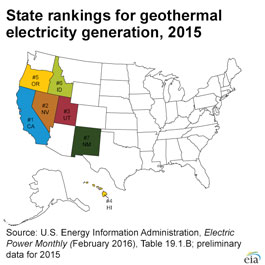Some applications of geothermal energy use the earth's temperatures near the surface, while others require drilling miles into the earth. There are three main types of geothermal energy systems:
- Direct use and district heating systems
- Electricity generation power plants
- Geothermal heat pumps
Direct use and district heating systems
Direct use and district heating systems use hot water from springs or reservoirs located near the surface of the earth. Ancient Roman, Chinese, and Native American cultures used hot mineral springs for bathing, cooking, and heating. Today, many hot springs are still used for bathing, and many people believe the hot, mineral-rich waters have natural healing powers.
Geothermal energy is also used to heat buildings through district heating systems. Hot water near the earth's surface is piped directly into buildings and industries for heat. A district heating system provides heat for most of the buildings in Reykjavik, Iceland.
Industrial applications of geothermal energy include food dehydration, gold mining, and milk pasteurizing. Dehydration, or the drying of vegetable and fruit products, is the most common industrial use of geothermal energy.
Geothermal electricity generation
The United States leads the world in the amount of electricity generated with geothermal energy. Geothermal electricity generation requires water or steam at high temperatures (300° to 700°F). Geothermal power plants are generally built where geothermal reservoirs are located within a mile or two of the earth's surface. In 2015, U.S. geothermal power plants produced about 16.8 billion kilowatthours (kWh), or 0.4% of total U.S. electricity generation. In 2015, seven states had geothermal power plants.
Share of U.S. geothermal electricity produced by each state, 2015:
| California | 74% |
| Nevada | 20% |
| Utah | 3% |
| Hawaii | 1.4% |
| Oregon | 1.1% |
| Idaho | 0.6% |
| New Mexico | 0.1% |
Geothermal heat pumps
Geothermal heat pumps use the constant temperatures near the surface of the earth to heat and cool buildings. Geothermal heat pumps transfer heat from the ground (or water) into buildings during the winter and reverse the process in the summer.
Geothermal energy contributes a significant share of electricity generation in several countries
In 2013, twenty countries, including the United States, generated a total of about 70 billion kWh of electricity from geothermal energy.1 Indonesia was the second-largest geothermal power producer after the United States, at about 11 billion kWh of electricity, which equaled approximately 5% of Indonesia's total power generation. Iceland was the seventh-largest producer at about 5 billion kWh of electricity, but the largest share of its total electricity generation was from geothermal energy at 27%.
1Based on data published by U.S. Energy Information Administration in May 2016.




